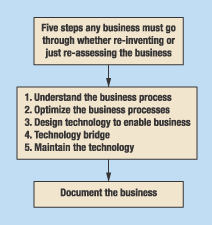Technology at Work: Using existing desktop technology to increase productivity
Dec. 2001 Vol. 222 No. 12 Feature Article TECHNOL0GY AT WORK Using existing desktop technology to increase productivity Fred Pratt, DYONYX, Houston &
TECHNOL0GY AT WORKUsing existing desktop technology to increase productivityFred Pratt, DYONYX, Houston
Business-focused IT plan. Faced with increasingly sophisticated IT tools, most companies’ business executives have become isolated from their IT departments, other than approving budgets to purchase new technology. IT has been allowed to become a company within a company. Increasingly, business executives have begun questioning how to better leverage IT as a strategic business tool. The E&P company learned that among the real productivity issues were how they managed back-office functions, tracked billing, performed cost accounting and managed partners. A multi-step process, focusing on three fundamental information areas – business, technical and support – showed management a more logical, productive business and IT direction. The consulting firm dissected the company to determine the most critical business processes, then traced these to see each person’s daily workflow, documenting and tracing this workflow and presenting results for management action.
Productivity challenges. Since theirs was a typical E&P office, management was surprised by the findings. For example, serving a staff of 92, the daily drilling report was photocopied 79 times and reentered into four different systems. Yet, nobody upstream or downstream knew what would be done with all these copies, or even which parts were extracted and compiled into other reports. The solution was relatively simple: posting the drilling report on a computer-network bulletin board, eliminating all paper copies. In fact, obtaining the daily drilling report from rigs was an exercise in wasted manpower itself. Contractors on the rigs would write up the report and fax it to the office, where it was keyed into the computer system. In addition to wasted time, re-keying information allowed for human error to intervene. Yet, excess man-hours grew unchecked, with each person receiving the report, extracting specific information and inserting into their own reports to compile different information, such as current well depth, how much was spent against the AFE, or whether it was a credited plan. The daily drilling report was only one aspect of waste and duplication. Only 5% of desktop-computer capability was utilized, which was originally why the company decided it had an IT problem. Since technology should allow faster, cheaper and better work, when it does not, the blame generally gets directed toward someone or something in IT. However, the reality is that work processes are not necessarily efficient, and IT is only a process enabler. Information model is critical. A strategic plan is vital because, with active participation of business units, it brings together key elements to create the appropriate work-process change. Companies must begin at the most strategic level of the company’s vision, beginning with steering-committee members. Next, the IT consultant interviews each workgroup, analyzes user documentation and optimizes the work processes through the steering committee as a team. After the model’s technical work is complete, most companies quit; but the remaining support work is critical, because it’s more focused on continuous improvement. In other words, did the company accomplish what it expected? Are there areas that can be tweaked? How can the work processes be further optimized? Being proactive keeps the business processes on track. Results. The company liked the original analysis so well that their engineering group applied the results to its drilling process, reducing required drilling time to 45 weeks from 52 weeks. More importantly, it noted that although this saved a considerable amount of money, it could now get revenue production online seven weeks earlier. Additionally, there were significant, unexpected manpower improvements. Having accepted findings of inefficient work process, reducing headcount would have been a likely next step; but management did not do that. The company wanted to improve throughput so it could handle more volume, i.e., optimize processes to improve productivity. That allowed the company to take on new business and grow without sacrificing its workforce. Ultimately, by working with a business-oriented IT team, the company made a decision that never would have occurred without work-process analysis and a strategic plan: It outsourced the entire IT group. Next, it dispersed the IT support people into each business unit so they could have local representation for quick help whenever needed. Conclusion. The bottom line was to break down barriers separating the company’s business side from its IT department. By doing that, the IT people could more effectively understand business objectives and exploit these in the company’s best interests. By optimizing workflow, virtually any company will see immediate improvement in business processes without installing a single piece of new technology on the desktop. Few companies, weary of the expensive "new technology" syndrome, would challenge the attractiveness of that. |
- Prices and governmental policies combine to stymie Canadian upstream growth (February 2024)
- U.S. producing gas wells increase despite low prices (February 2024)
- U.S. drilling: More of the same expected (February 2024)
- U.S. oil and natural gas production hits record highs (February 2024)
- U.S. upstream muddles along, with an eye toward 2024 (September 2023)
- Canada's upstream soldiers on despite governmental interference (September 2023)
- Applying ultra-deep LWD resistivity technology successfully in a SAGD operation (May 2019)
- Adoption of wireless intelligent completions advances (May 2019)
- Majors double down as takeaway crunch eases (April 2019)
- What’s new in well logging and formation evaluation (April 2019)
- Qualification of a 20,000-psi subsea BOP: A collaborative approach (February 2019)
- ConocoPhillips’ Greg Leveille sees rapid trajectory of technical advancement continuing (February 2019)



